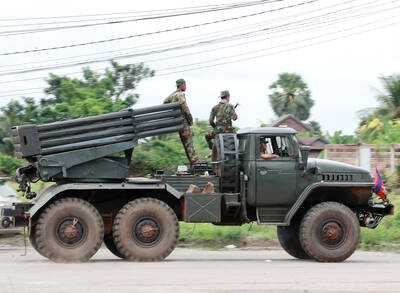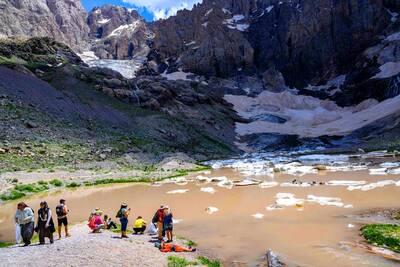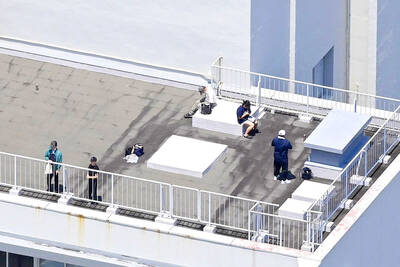Engineers moved ahead yesterday with preparations for a well “kill” operation that officials hope would permanently plug the oil leak behind the most severe US environmental disaster ever.
A major vessel charged with drilling a relief well to finally stop the BP oil spill arrived back at the Gulf of Mexico well site on Saturday after briefly evacuating because of a tropical storm.
US Coast Guard Admiral Thad Allen said a first chance to seal the well for good could come in the next three to five days, as response crews quickly scaled operations back up after the storm fizzled.

PHOTO: AFP
“That is a very rough estimate, three to five days from now,” Allen said.
The returning drill rig, Development Driller 3 (DD3), was among 10 ships that evacuated the area ahead of Tropical Storm Bonnie. It was to begin reattaching to the well site immediately, according to the US official overseeing the spill response.
A cap over the wellhead has shut in leaking oil since July 15.
However, officials and residents are desperate to permanently resolve the environmental disaster, more than three months after the April 20 explosion aboard the BP-leased Deepwater Horizon oil platform, which killed 11 workers and sank the rig.
The International Energy Agency estimates that between 2.3 million and 4.5 million barrels of crude have gushed into the sea as a result of the leak.
BP spokesman Bryan Ferguson said it would take about 21 hours to reconnect the DD3 to drilling operations 1,500m below the sea surface.
The rig is drilling the first of two relief wells that will be used to definitively plug the devastating spill.
BP and US officials currently plan two operations to kill the well.
The first, a “static kill,” involves pumping heavy drilling fluid known as mud through the blowout preventer valve system that sits on top of the well, and then injecting cement to seal it.
The process is similar to a “top kill” attempt that failed in May, but officials say the cap now in place over the leak will make the operation easier and more likely to succeed.
However, BP and US responders have said the ultimate solution to the leak will be via the relief wells, which will intersect the original well.
Using the same process as the static kill, drilling fluid, which is denser than oil, will be pumped via the relief well until the flow of crude is overcome, allowing the damaged well to be sealed with cement.
Before either can begin, the last section of the relief well must be secured with a 915m piece of steel pipe called a “casing run,” which will be cemented in place.
“You’re probably into three to five days from now when they might be able to be in a position to have the casing pipe in place and we could probably start the static kill at that point,” Allen said.
The spill, which has now washed up oil along the shorelines of all five US states on the Gulf Coast, has left residents facing economic and environmental disaster.
However, amid high anxiety over the storm and the evacuation of vessels that aimed to keep workers and equipment safe, some experts said the high waves kicked up by Bonnie might actually help dissolve some of the oil faster.
“We expect that Bonnie should help dissipate and weather the oil that’s at the surface, it will spread the surface slick out and thereby lower concentrations,” said Jane Lubchenco, who heads the National Oceanic and Atmospheric Administration.
The storm would “also cause more natural dispersion, again lowering the concentration and making it more available to natural bacteria that are in the water,” she said.
Other experts argue that surface currents bolstered by high winds would likely shift the near-surface oil closer to the Gulf Coast and spread it over a larger area, and that a severe storm surge from the likes of a hurricane could send fouled water far up into the bayous, contaminating fragile spawning grounds for fish and shrimp.
In Larose, a Louisiana town near the Mississippi River delta, a shrimper named Barry who now does spill clean-up work for BP said Gulf Coast residents dodged a bullet when Bonnie fizzled.
“If we can get lucky and just have Bonnies, we would fare a lot better,” he said. “A hurricane anything more than minimal size, even a big tropical storm, is going to be devastating to this entire area.”

POLITICAL PATRIARCHS: Recent clashes between Thailand and Cambodia are driven by an escalating feud between rival political families, analysts say The dispute over Thailand and Cambodia’s contested border, which dates back more than a century to disagreements over colonial-era maps, has broken into conflict before. However, the most recent clashes, which erupted on Thursday, have been fueled by another factor: a bitter feud between two powerful political patriarchs. Cambodian Senate President and former prime minister Hun Sen, 72, and former Thai prime minister Thaksin Shinawatra, 76, were once such close friends that they reportedly called one another brothers. Hun Sen has, over the years, supported Thaksin’s family during their long-running power struggle with Thailand’s military. Thaksin and his sister Yingluck stayed

In the sweltering streets of Jakarta, buskers carry towering, hollow puppets and pass around a bucket for donations. Now, they fear becoming outlaws. City authorities said they would crack down on use of the sacred ondel-ondel puppets, which can stand as tall as a truck, and they are drafting legislation to remove what they view as a street nuisance. Performances featuring the puppets — originally used by Jakarta’s Betawi people to ward off evil spirits — would be allowed only at set events. The ban could leave many ondel-ondel buskers in Jakarta jobless. “I am confused and anxious. I fear getting raided or even

Kemal Ozdemir looked up at the bare peaks of Mount Cilo in Turkey’s Kurdish majority southeast. “There were glaciers 10 years ago,” he recalled under a cloudless sky. A mountain guide for 15 years, Ozdemir then turned toward the torrent carrying dozens of blocks of ice below a slope covered with grass and rocks — a sign of glacier loss being exacerbated by global warming. “You can see that there are quite a few pieces of glacier in the water right now ... the reason why the waterfalls flow lushly actually shows us how fast the ice is melting,” he said.

Residents across Japan’s Pacific coast yesterday rushed to higher ground as tsunami warnings following a massive earthquake off Russia’s far east resurfaced painful memories and lessons from the devastating 2011 earthquake and nuclear disaster. Television banners flashed “TSUNAMI! EVACUATE!” and similar warnings as most broadcasters cut regular programming to issue warnings and evacuation orders, as tsunami waves approached Japan’s shores. “Do not be glued to the screen. Evacuate now,” a news presenter at public broadcaster NHK shouted. The warnings resurfaced memories of the March 11, 2011, earthquake, when more than 15,000 people died after a magnitude 9 tremor triggered a massive tsunami that